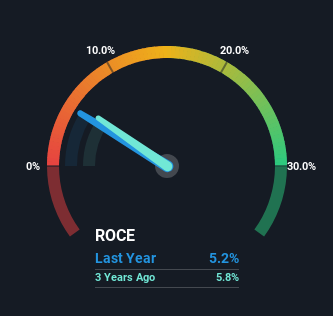
Finding a business that has the potential to grow substantially is not easy, but it is possible if we look at a few key financial metrics. Typically, we'll want to notice a trend of growing return on capital employed (ROCE) and alongside that, an expanding base of capital employed. Basically this means that a company has profitable initiatives that it can continue to reinvest in, which is a trait of a compounding machine. However, after briefly looking over the numbers, we don't think CITIC (HKG:267) has the makings of a multi-bagger going forward, but let's have a look at why that may be.
Return On Capital Employed (ROCE): What Is It?
Just to clarify if you're unsure, ROCE is a metric for evaluating how much pre-tax income (in percentage terms) a company earns on the capital invested in its business. The formula for this calculation on CITIC is:
Return on Capital Employed = Earnings Before Interest and Tax (EBIT) ÷ (Total Assets - Current Liabilities)
0.052 = CN¥307b ÷ (CN¥11t - CN¥5.4t) (Based on the trailing twelve months to December 2023).
So, CITIC has an ROCE of 5.2%. On its own that's a low return, but compared to the average of 2.9% generated by the Industrials industry, it's much better.
View our latest analysis for CITIC

Above you can see how the current ROCE for CITIC compares to its prior returns on capital, but there's only so much you can tell from the past. If you're interested, you can view the analysts predictions in our free analyst report for CITIC .
The Trend Of ROCE
There are better returns on capital out there than what we're seeing at CITIC. The company has employed 73% more capital in the last five years, and the returns on that capital have remained stable at 5.2%. Given the company has increased the amount of capital employed, it appears the investments that have been made simply don't provide a high return on capital.
Another thing to note, CITIC has a high ratio of current liabilities to total assets of 48%. This effectively means that suppliers (or short-term creditors) are funding a large portion of the business, so just be aware that this can introduce some elements of risk. Ideally we'd like to see this reduce as that would mean fewer obligations bearing risks.
What We Can Learn From CITIC's ROCE
In conclusion, CITIC has been investing more capital into the business, but returns on that capital haven't increased. Unsurprisingly, the stock has only gained 5.0% over the last five years, which potentially indicates that investors are accounting for this going forward. As a result, if you're hunting for a multi-bagger, we think you'd have more luck elsewhere.
CITIC does have some risks, we noticed 2 warning signs (and 1 which makes us a bit uncomfortable) we think you should know about.
While CITIC may not currently earn the highest returns, we've compiled a list of companies that currently earn more than 25% return on equity. Check out this free list here.
New: AI Stock Screener & Alerts
Our new AI Stock Screener scans the market every day to uncover opportunities.
• Dividend Powerhouses (3%+ Yield)
• Undervalued Small Caps with Insider Buying
• High growth Tech and AI Companies
Or build your own from over 50 metrics.
Have feedback on this article? Concerned about the content? Get in touch with us directly. Alternatively, email editorial-team (at) simplywallst.com.
This article by Simply Wall St is general in nature. We provide commentary based on historical data and analyst forecasts only using an unbiased methodology and our articles are not intended to be financial advice. It does not constitute a recommendation to buy or sell any stock, and does not take account of your objectives, or your financial situation. We aim to bring you long-term focused analysis driven by fundamental data. Note that our analysis may not factor in the latest price-sensitive company announcements or qualitative material. Simply Wall St has no position in any stocks mentioned.
About SEHK:267
CITIC
Operates in financial services, advanced intelligent manufacturing, advanced materials, consumption, urbanization, resources and energy, and engineering contracting businesses worldwide.
Good value with acceptable track record.

